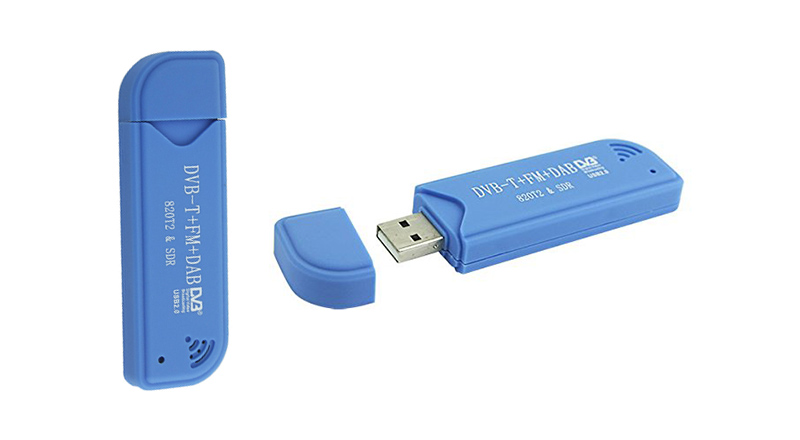Introduction: What is RTL-SDR?
RTL-SDR is a multipurpose SDR device of great utility with physical size very similar to that of a pen drive. Being a Software-defined Radio device, thanks to the chipset inside, belonging to the Radios technology defined by Software, its functionality is multiplied by each computer application that supports it.
A basic SDR system may consist of a personal computer equipped with a sound card, or other analog-to-digital converter, preceded by some form of RF front end.
It is composed of an RTL2832U chipset, a device that can be converted into the SDR receiver (RTL-SDR) that allows experimenting in the wide world of the radio-electric spectrum. This Software-Defined Radio (SDR) can tune into radio frequencies starting from 24MHz up to 2200MHz. The device is within the reach of anyone due to its small size and low cost, and it is very useful for radio professionals, as it represents an excellent signal receiving tool.
RTL-SDR: RTL2832U, DVB-T SDR, DVB-T Dongle [features, hardware, design]
Although there are several models, the RTL2832U is the one with the widest range of frequencies, between 50MHz and 2200MHz, with a small interruption between 1100 MHz and 1250 MHz.
The output of the RTL2832U gives 8-bit samples of the I/Q signals, and its higher highest theoretical sampling frequency is 3.2 MS/s. However, quality or samples with this velocity are can be lost and it is recommended to use a frequency of 2.56 MS/s or less, which basically allows us to simultaneously process 2 MHz of the radio spectrum between 50 MHz and 2200 MHz using the USB ports.
Features and Components
The maximum sampling rate for this RTL-SDR device is 3.2 MS/s (mega samples/per second). Normal output is 8 bits, but the efficiency (ENOB) is estimated at 7. Changes in software can enhance this value. It has an input impedance of about 75 Ohms because it is intended for television. The offset loss when using 50 Ohm wiring is negligible (around 0.177 dB).
- RTL28232U-based USB stick
- Operating frequency range 24 – 1750 MHz
- 2.0 Msps sample rate
- Native resolution – 8 bits
- Carrier Type – 2 K/ 8K
- Modulation – QPSK, 16 QAM, 64 QAM
Frequency range
The frequency range is usually dependent on the type of Tuner.
- Tuner | Frequency range
- Fitipower FC0013 | 22 – 1100 MHz
- Rafael Micro R820T | 24 – 1766 MHz
- FCI FC2580 | 146 – 308 MHz and 438 – 924 MHz
- Elonics E4000 | 52 – 2200 MHz (Gap from 1100 MHz – 1250 MHz)
- Fitipower FC0012 | 22 – 948.6 MHz
- Rafael Micro R828D | 24 – 1766 MHz

RTL-SDR Usage
There are dozens of applications developed for the RTL-SDR dongle. It works as a normal broadband radio receiver, but why should you choose this simple SDR device? Its difference lies in the specific functionalities and performance in practice.
- It can decode beeper signals, balloon probes, telemetry of several satellites, etc.
- It’s multimode receiver: AM, WFM, NFM, DSB, USB, LSB, DRM, CW.
- RTL-SDR can continuously visualize 2 MHz of bandwidth and record this spectrum.
- You can receive weather images from NOAA satellites only using this simple device.
- It demodulates trunking (several digital voice modes).
- You can connect it to a mobile phone and monitor the spectrum from the mobile, perform radio spectrum scans, generate tables, etc.
- It’s capable of analog TV visualization in Black and White.
- It can receive GPS in real time (receive AIS (ships), ADS-B and ACARS (aircraft) and locate them on a map).
- RTL-SDR can also become a spectrum analyzer with multiple functionalities, perform remote monitoring through the data network.
- It follows different technologies of the Trunking systems.
- It receives DAB and digital TV DVB-T (a European standard of digital TV). Few more examples (I’ll add those).
Conclusion
The RTL-SDR is a tool of unlimited use. It represents an economic platform in development and it is used worldwide for educational and experimentation purposes mainly by radio professionals but also by all enthusiasts interested in SDR devices. It’s really an inexpensive and highly affordable device (~ $20) with lot of applications. The maximum sampling rate is 3.2 MS/s, you should give it a chance.

![KeyGrabber USB [Pico, Nano, WiFi, TimeKeeper] KeyGrabber USB [Pico, Nano, WiFi, TimeKeeper]](https://cdn.cyberpunk.rs/wp-content/uploads/2019/02/keygrabber_bg-500x275.jpg)

![HackRF One [Great Scott Gadgets] HackRF One [Great Scott Gadgets]](https://cdn.cyberpunk.rs/wp-content/uploads/2018/11/hackrf_one_bg-500x275.jpg)